Related Research Articles

Horus or Her, Heru, Hor, Har in Ancient Egyptian, is one of the most significant ancient Egyptian deities who served many functions, most notably god of kingship and the sky. He was worshipped from at least the late prehistoric Egypt until the Ptolemaic Kingdom and Roman Egypt. Different forms of Horus are recorded in history and these are treated as distinct gods by Egyptologists. These various forms may possibly be different manifestations of the same multi-layered deity in which certain attributes or syncretic relationships are emphasized, not necessarily in opposition but complementary to one another, consistent with how the Ancient Egyptians viewed the multiple facets of reality. He was most often depicted as a falcon, most likely a lanner falcon or peregrine falcon, or as a man with a falcon head.

Hotepsekhemwy is the Horus name of an early Egyptian king who was the founder of the 2nd dynasty. The exact length of his reign is not known; the Turin canon suggests an improbable 95 years while the Ancient Egyptian historian Manetho reports that the reign of "Boëthôs" lasted for 38 years. Egyptologists consider both statements to be misinterpretations or exaggerations. They credit Hotepsekhemwy with either a 25- or a 29-year rule.

Nynetjer is the Horus name of the third pharaoh of the Second Dynasty of Egypt. The length of his reign is unknown. The Turin Canon suggests an improbable reign of 96 years and Egyptian historian Manetho suggested that Nynetjer's reign lasted 47 years. Egyptologists question both statements as misinterpretations or exaggerations. They generally credit Nynetjer with a reign of either 43 years or 45 years. Their estimation is based on the reconstructions of the well known Palermo Stone inscription reporting the years 7–21, the Cairo Stone inscription reporting the years 36–44. According to different authors, Nynetjer ruled Egypt from c. 2850 BC to 2760 BC or later from c. 2760 BC to 2715 BC.

Den, also known as Hor-Den, Dewen and Udimu, is the Horus name of a pharaoh of the Early Dynastic Period who ruled during the First Dynasty of Egypt. He is the best archaeologically-attested ruler of this period. Den is said to have brought prosperity to his realm and numerous innovations are attributed to his reign. He was the first to use the title "King of Lower and Upper Egypt", and the first depicted as wearing the double crown. The floor of his tomb at Umm El Qa'ab near Abydos is made of red and black granite, the first time in Egypt this hard stone was used as a building material. During his long reign he established many of the customs of court ritual and royalty used by later rulers and he was held in high regard by his immediate successors.
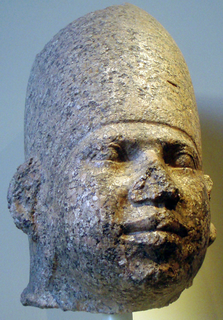
Huni was an ancient Egyptian king and the last pharaoh of the 3rd dynasty during the Old Kingdom period. Following the Turin king list, he is commonly credited with a reign of 24 years, ending c. 2613 BC.

Iry-Hor or Ro was a predynastic pharaoh of Upper Egypt during the 32nd century BC. Iry-Hor's existence was debated, with the Egyptologist Toby Wilkinson contesting the reading and signification of his name. However, continuing excavations at Abydos in the 1980s and 1990s and the discovery in 2012 of an inscription of Iry-Hor in the Sinai confirmed his existence. Iry-Hor is the earliest ruler of Egypt known by name and is sometimes cited as the earliest-living historical person known by name.
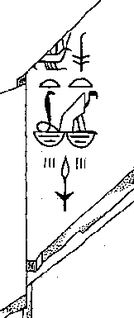
Weneg, also known as Weneg-Nebty, is the throne name of an early Egyptian king, who ruled during the second dynasty. Although his chronological position is clear to Egyptologists, it is unclear for how long King Weneg ruled. It is also unclear as to which of the archaeologically identified Horus-kings corresponds to Weneg.

Senedj was an early Egyptian king (pharaoh), who may have ruled during the 2nd dynasty. His historical standing remains uncertain. His name is included in the kinglists of the Ramesside era, although it is written in different ways: While the kinglist of Abydos imitates the archaic form, the Royal Canon of Turin and the kinglist of Sakkara form the name with the hieroglyphic sign of a plucked goose.
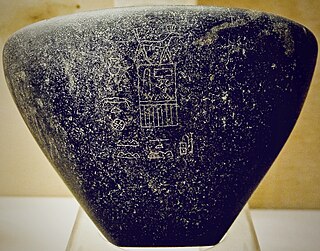
Seth-Peribsen is the serekh name of an early Egyptian monarch (pharaoh), who ruled during the Second Dynasty of Egypt. His chronological position within this dynasty is unknown and it is disputed who ruled both before and after him. The duration of his reign is also unknown.
The royal titulary or royal protocol is the standard naming convention taken by the pharaohs of ancient Egypt. It symbolises worldly power and holy might and also acts as a sort of mission statement for the reign of a monarch.
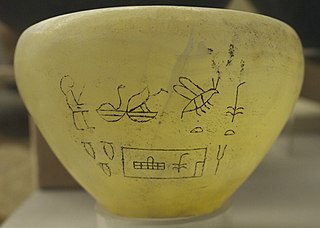
Semerkhet is the Horus name of an early Egyptian king who ruled during the first dynasty. This ruler became known through a tragic legend handed down by the ancient Greek historian, Manetho, who reported that a calamity of some sort occurred during Semerkhet's reign. The archaeological records seem to support the view that Semerkhet had a difficult time as king and some early archaeologists even questioned the legitimacy of Semerkhet's succession to the Egyptian throne.

Egyptian sun temples were ancient Egyptian temples to the sun god Ra. The term has come to mostly designate the temples built by six or seven pharaohs of the Fifth Dynasty during the Old Kingdom period. However, sun temples would make a reappearance a thousand years later under Akhenaten in the New Kingdom with his building of the Karnak Temple in Thebes.
The ancient Egyptian Shuti, a two-feather adornment for crowns, is part of a series of hieroglyphs for "crowns"; usage as a hieroglyph is not as common as the actual crown represented in Egyptian art, and artworks.

The Horus name is the oldest known and used crest of Ancient Egyptian rulers. It belongs to the "great five names" of an Egyptian pharaoh. However, modern Egyptologists and linguists are starting to prefer the more neutral term: the "serekh name". This is because not every pharaoh placed the falcon, which symbolizes the deity Horus, atop his serekh.

Sekhemre Sementawy Djehuti was possibly the second king of the Theban 16th Dynasty reigning over parts of Upper Egypt during the Second Intermediate Period. Alternatively, he may be a king of the late 13th Dynasty or the fourth king of the 17th Dynasty. Djehuty is credited with a reign of 3 years in the first entry of the 11th column of the Turin canon. According to Egyptologists Kim Ryholt and Darrell Baker, he was succeeded by Sobekhotep VIII.

Neferkasokar was an Ancient Egyptian king (pharaoh) who may have ruled in Egypt during the 2nd dynasty. Very little is known about him, since no contemporary records about him have been found. Rather his name has been found in later sources.

Sneferka is the serekh-name of an early Egyptian king who may have ruled at the end of the 1st dynasty. The exact length of his reign is unknown, but thought to have been very short and his chronological position is unclear.
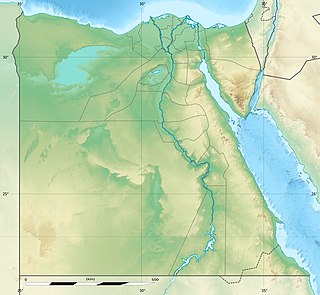
The Pyramid of Reherishefnakht is the tomb of the ancient Egyptian official Reherishefnakht. It is located in south Saqqara and was built right next to the Pyramid of the 6th Dynasty Pharaoh Pepi I. Reherishefnakht's pyramid however was probably built at the end of the 11th Dynasty or the beginning of the 12th Dynasty. It is the oldest Egyptian pyramid built for a person who was not a member of the royal family. The pyramid was discovered a few years before it was first excavated by Audran Labrousse and the Mission Archéologique Française de Saqqâra in 2005.
Stork (Pharaoh) was an ancient Egyptian ruler (Pharaoh) from the Pre-dynastic period of Egypt. Most modern scholars doubt that he ever existed.
References
- ↑ Jürgen Schraten, Zur Aktualität von Jan Assmann: Einleitung in sein Werk (Springer-Verlag, 11.11.2010) page 59.
- ↑ Studien Zur Altagyptischen Kultuer 2008. page 158 zur Altägyptischen Kultur, Band 37.
- ↑ Barry Kemp (a1), Andrew Boyce and James Harrell, The Colossi from the Early Shrine at Coptos in Egypt, in: Cambridge Archaeological Journal Volume 10, Issue 2April 2000, 233.
- ↑ THE DYNASTY 0 Pahroeohs.
- ↑ Felde, Rolf: Gottheiten, Pharaonen und Beamte im alten Ägypten, Norderstedt 2017, page 125.
- ↑ Michael Hoveler Muller, Zu den fruhzeitlichen Konigen "Fingerchnecke und und Fisch aus dem Grab U-j in Umm el Qaab. page 159.
| This Ancient Egypt biographical article is a stub. You can help Wikipedia by expanding it. |